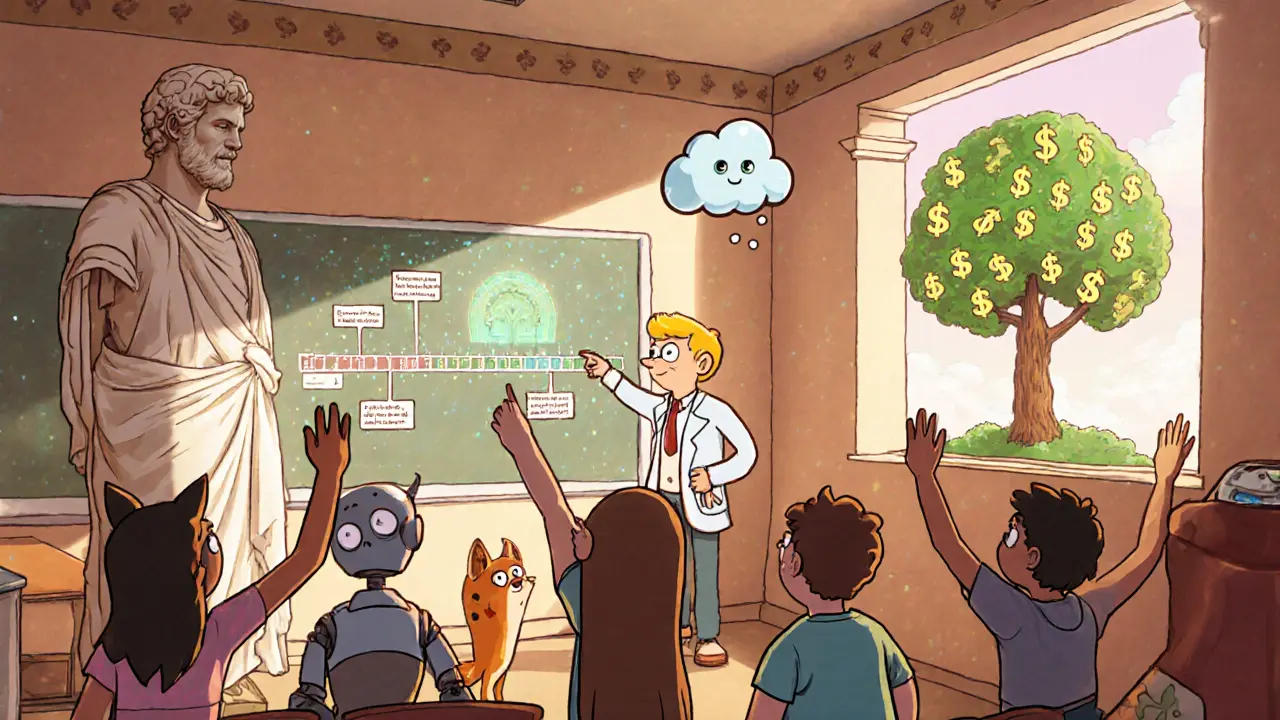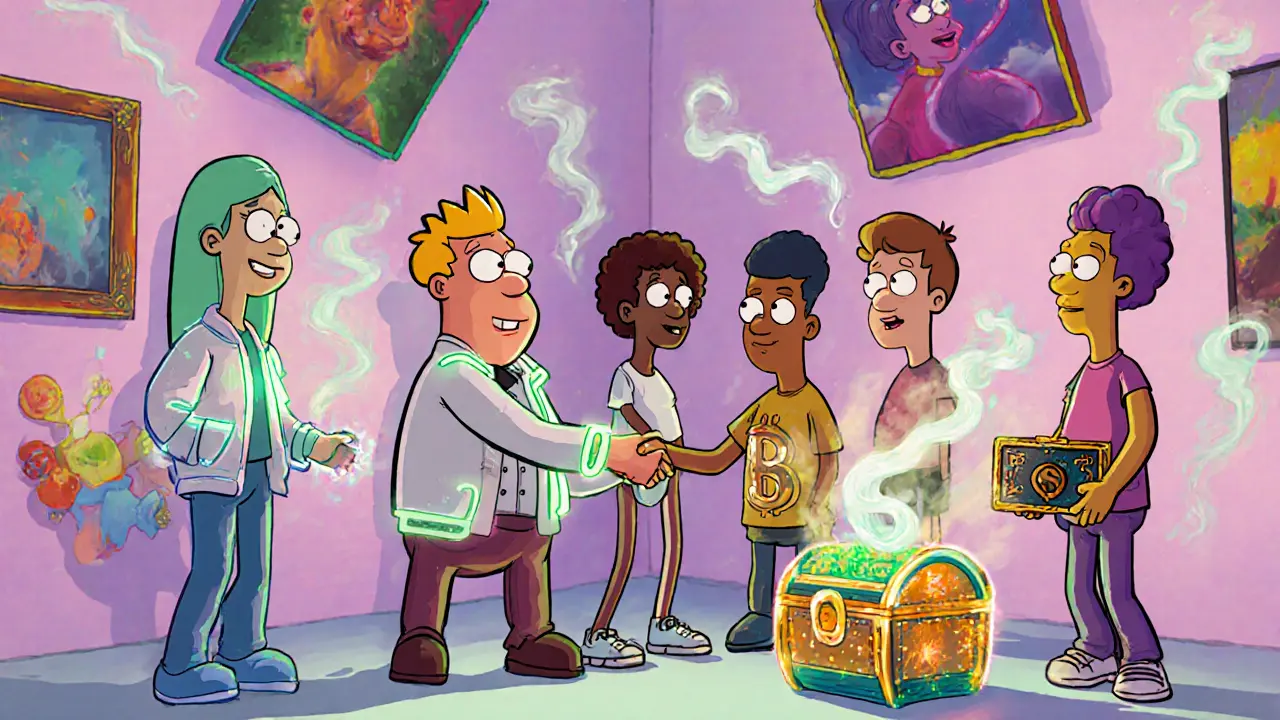Blockchain Transaction Cost Calculator
Transaction fee estimate will appear here
Imagine walking into a virtual art gallery where every painting is owned by someone real - not a company, not an algorithm, but a person like you. You bump into a friend from Tokyo, shake their digital hand, and together you buy a rare digital jacket for your avatar using cryptocurrency. No ads. No tracking. No middleman. This isn’t science fiction. It’s happening right now in the blockchain metaverse.
Unlike Facebook or Instagram, where your likes and posts fuel corporate profits, the blockchain metaverse puts you in control. Your avatar? It’s an NFT you own. Your land? It’s a token on the blockchain. Your earnings from a virtual event? They go straight to your wallet. This isn’t just a better version of social media - it’s a complete rewrite of how people connect online.
What Makes Social Interaction Different in the Blockchain Metaverse?
Traditional social media is built on attention economies. You scroll, you click, you watch ads. The platform owns your data, your identity, and your interactions. In the blockchain metaverse, the rules are flipped. You’re not a product - you’re a participant. Your presence has value because you own it.
When you log in, you’re not just typing a username. You’re stepping into a 3D world as your avatar - a digital twin that can be customized, upgraded, and traded. These avatars are often backed by NFTs, meaning they’re unique, verifiable, and yours forever. If you buy a rare hat for your avatar on one platform, you can wear it on another - if the platforms support interoperability. That’s something no other social network can do.
Real-time voice and movement tracking make conversations feel natural. You can stand in a circle with five people, laugh at the same joke, and see their expressions change. It’s not a Zoom call with grid squares - it’s a shared space that exists even when you’re offline. That’s called a persistent universe. It doesn’t shut down when you close your app. It keeps running, growing, evolving.
How People Actually Connect - Beyond the Avatars
People aren’t just hanging out in virtual parks. They’re doing real things together.
- Artists host live NFT art auctions inside virtual galleries, where buyers bid in crypto and watch the artwork materialize in 3D before their eyes.
- Companies hold team meetings in 3D conference rooms where employees from Brazil, Indonesia, and Canada share the same space - no plane tickets needed.
- Musicians perform concerts in open-air arenas with thousands of attendees, all wearing custom merch they bought as NFTs.
- Gamers team up in play-to-earn worlds, where winning a match doesn’t just give you bragging rights - it gives you tokens you can cash out.
These aren’t gimmicks. They’re functional replacements for real-world activities. A study from a Web3 research group in early 2025 found that over 62% of active users in major blockchain metaverse platforms reported feeling more connected to their peers than they did on traditional social networks. Why? Because interactions are deeper, more personal, and tied to real ownership.
The Virtual Economy: More Than Just Crypto
Money moves differently here. Instead of ads paying for your attention, your time and creativity pay you back.
You can design a virtual storefront, rent it out, and earn rent in cryptocurrency. You can build a mini-game that others play and earn a cut of the in-game currency. You can even become a virtual real estate agent, helping newcomers buy land in popular districts like Decentraland’s Fashion Street or The Sandbox’s Creative Hub.
Platforms use their own tokens - like MANA, SAND, or AXS - to power transactions. These aren’t just digital cash. They’re governance tokens. Holders can vote on platform upgrades, new features, or even how ad space is allocated. That’s democracy built into the code.
But it’s not all smooth sailing. Gas fees - the cost to move crypto on the blockchain - can spike during busy times. One user in Berlin told me he spent $18 just to list a digital shirt for sale because Ethereum was congested. That’s a dealbreaker for casual users. Newer platforms are switching to Layer-2 solutions like Polygon or Arbitrum to cut fees by 90%, making transactions cheaper and faster.
Why It’s Harder Than It Looks
For all the hype, getting started is still a hurdle.
You need a crypto wallet - MetaMask, Phantom, or Coinbase Wallet. You need to buy cryptocurrency, usually ETH or MATIC, and transfer it to your wallet. Then you need to connect that wallet to the metaverse platform. Then you need to pick an avatar, learn how to move in 3D, and figure out how to talk to people without a keyboard.
Most platforms still assume you’re comfortable with tech. If you’re not, you’ll feel lost. A 2025 survey of 1,200 new users showed that 43% gave up within the first 48 hours because the onboarding felt like solving a puzzle. The good news? Platforms are catching on. Now, many offer guided tours, AI assistants that walk you through setup, and even video tutorials inside the metaverse itself.
VR headsets help - but they’re not required. You can access most platforms through a browser or mobile app. The experience isn’t as immersive, but it’s enough to get started. Many users begin on their phone, then upgrade to VR once they’re hooked.
Who’s Using This - And Why
It’s not just gamers or crypto bros.
- Teachers are holding history lessons in recreated ancient Rome.
- Therapists are running group sessions in calming virtual forests for anxiety sufferers.
- Small businesses are opening virtual pop-up shops to reach global customers without paying rent.
- Nonprofits are hosting fundraising galas where attendees buy NFT tickets and donate crypto.
One nonprofit in Toronto raised $270,000 in a single night by selling NFTs of digital flowers - each flower represented a real tree they’d plant in the Amazon. The buyers got a 3D version of their flower in the metaverse, plus a photo of the real tree with their name on it.
These aren’t niche experiments. They’re proof that the blockchain metaverse isn’t just for techies. It’s becoming a tool for real human connection, creativity, and commerce.

The Future Is Already Here
By 2026, experts predict over 500 million people will have interacted with a blockchain metaverse platform - not as a game, but as a daily tool. That’s bigger than the entire user base of Twitter in 2020.
AI is helping too. Chatbots now moderate conversations, flagging hate speech or scams. They learn from user behavior to suggest friends, events, or places based on your interests. One platform in Japan uses AI to translate spoken language in real time - so a Spanish speaker can chat with a Korean speaker without typing a word.
Big brands are testing the waters. Nike has a virtual sneaker store. Gucci lets you try on digital bags before buying. Even universities are holding graduation ceremonies in the metaverse.
The biggest shift? People are starting to care more about what they own in digital space than what they own in physical space. A digital jacket from a virtual fashion show sold for $10,000 last year. Not because it’s warm. But because it’s rare, unique, and tied to a moment in time.
What You Can Do Today
You don’t need to wait for the future. Here’s how to start:
- Download a crypto wallet like MetaMask (free, browser extension).
- Buy a small amount of ETH or MATIC from a trusted exchange like Coinbase or Kraken.
- Visit a beginner-friendly platform like Spatial, Gather.town, or Decentraland.
- Create an avatar - no VR needed.
- Join a public event - there’s always a virtual art show, music night, or coffee chat happening.
- Say hi. Talk. Listen. You’re not just visiting. You’re becoming part of it.
The first time you shake someone’s hand in a virtual world and they smile back - that’s when it clicks. This isn’t about technology. It’s about humanity finding a new way to be together.
Can I really make money in the blockchain metaverse?
Yes. People earn money by selling digital land, designing virtual items, hosting events, or playing play-to-earn games. Some make a few dollars a week. Others earn full-time incomes. It’s not get-rich-quick - it’s work-based income in a new economy.
Do I need a VR headset to use the blockchain metaverse?
No. You can access most platforms through a web browser on your phone or computer. VR makes it more immersive, but it’s not required to participate, socialize, or earn.
Is the blockchain metaverse safe?
It’s safer than traditional social media in one key way: you control your data. But scams exist. Fake NFTs, phishing links, and impersonators are common. Always verify links, never share your wallet seed phrase, and stick to well-known platforms.
What’s the difference between the blockchain metaverse and regular video games?
In regular games, your items are locked inside the game. You can’t sell them, trade them, or take them elsewhere. In the blockchain metaverse, your items are yours - stored on the blockchain. You can sell them, rent them, or use them across different platforms if they support interoperability.
Why should I care about the blockchain metaverse if I don’t use crypto?
You don’t need to use crypto to benefit. The metaverse is changing how we work, learn, and connect. Companies are moving meetings there. Artists are selling work there. Schools are holding classes there. Even if you never buy an NFT, you’ll likely interact with someone who does - and understanding how it works helps you stay connected.
What you’re seeing now is just the beginning. The blockchain metaverse won’t replace the real world - but it’s becoming a real part of it. And the people who show up early? They’re not just playing. They’re building the next version of human connection.

Joy Whitenburg
November 11, 2025 AT 04:10Just tried Decentraland last night… honestly? I cried. Not because it was fancy, but because someone I met in a virtual coffee shop remembered my name the next time I logged in. No algorithm guessed it. They just… remembered. That’s the magic.
Brian Gillespie
November 12, 2025 AT 15:11This is real connection. Not likes. Not comments. Presence.
Phil Bradley
November 14, 2025 AT 12:11Wait-so you’re telling me I can own a digital jacket that costs more than my car and no one can take it away? That’s not freedom, that’s capitalism with better lighting. But also… I kinda want one. 😭